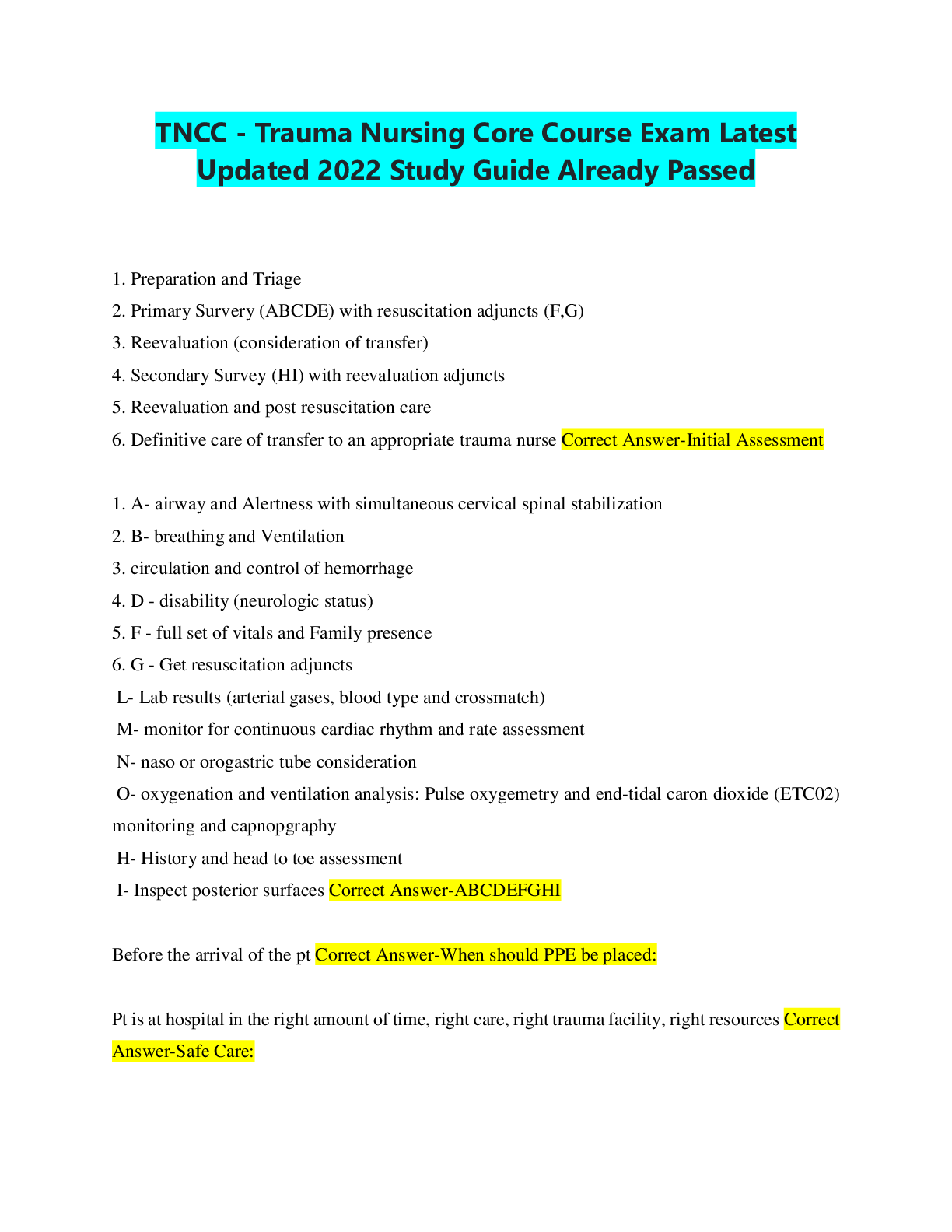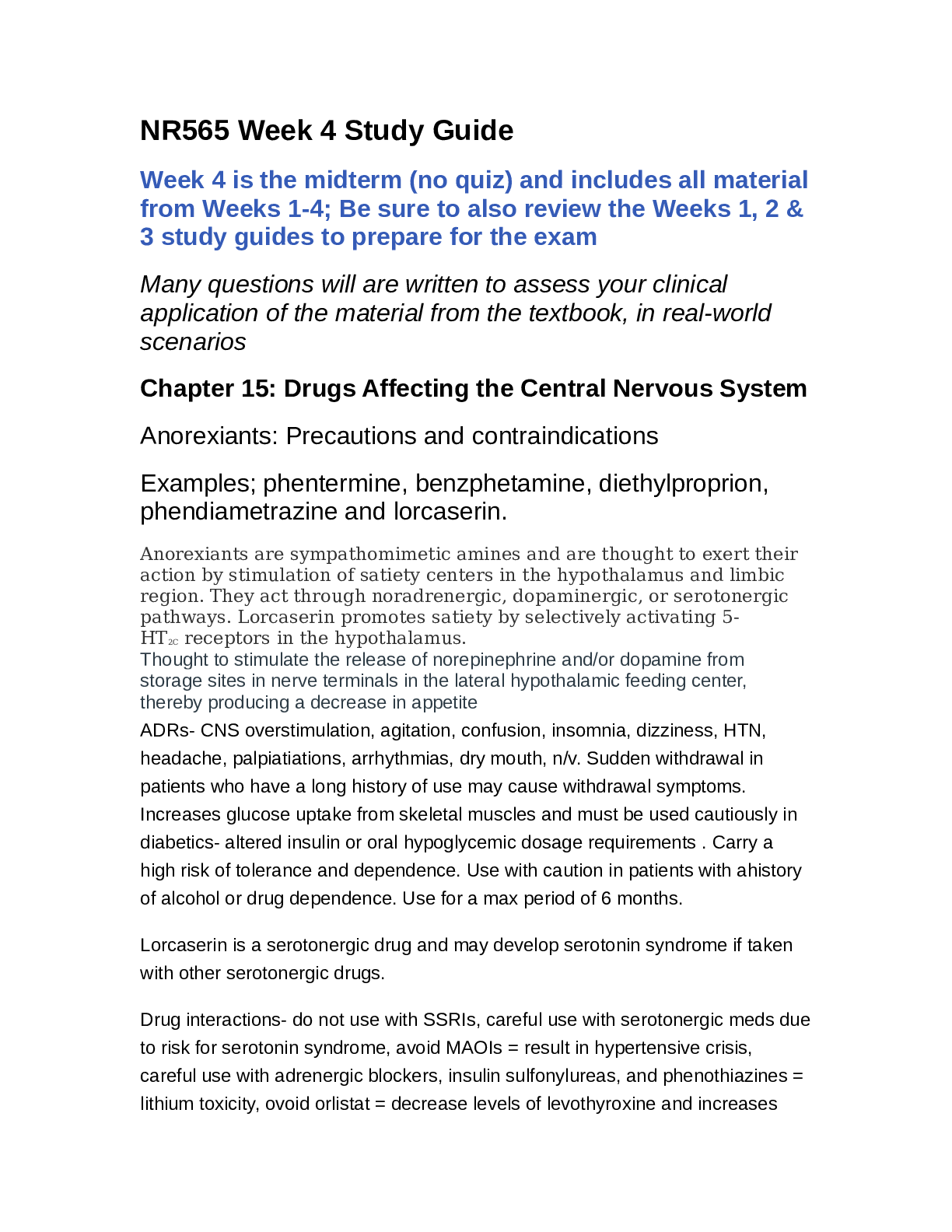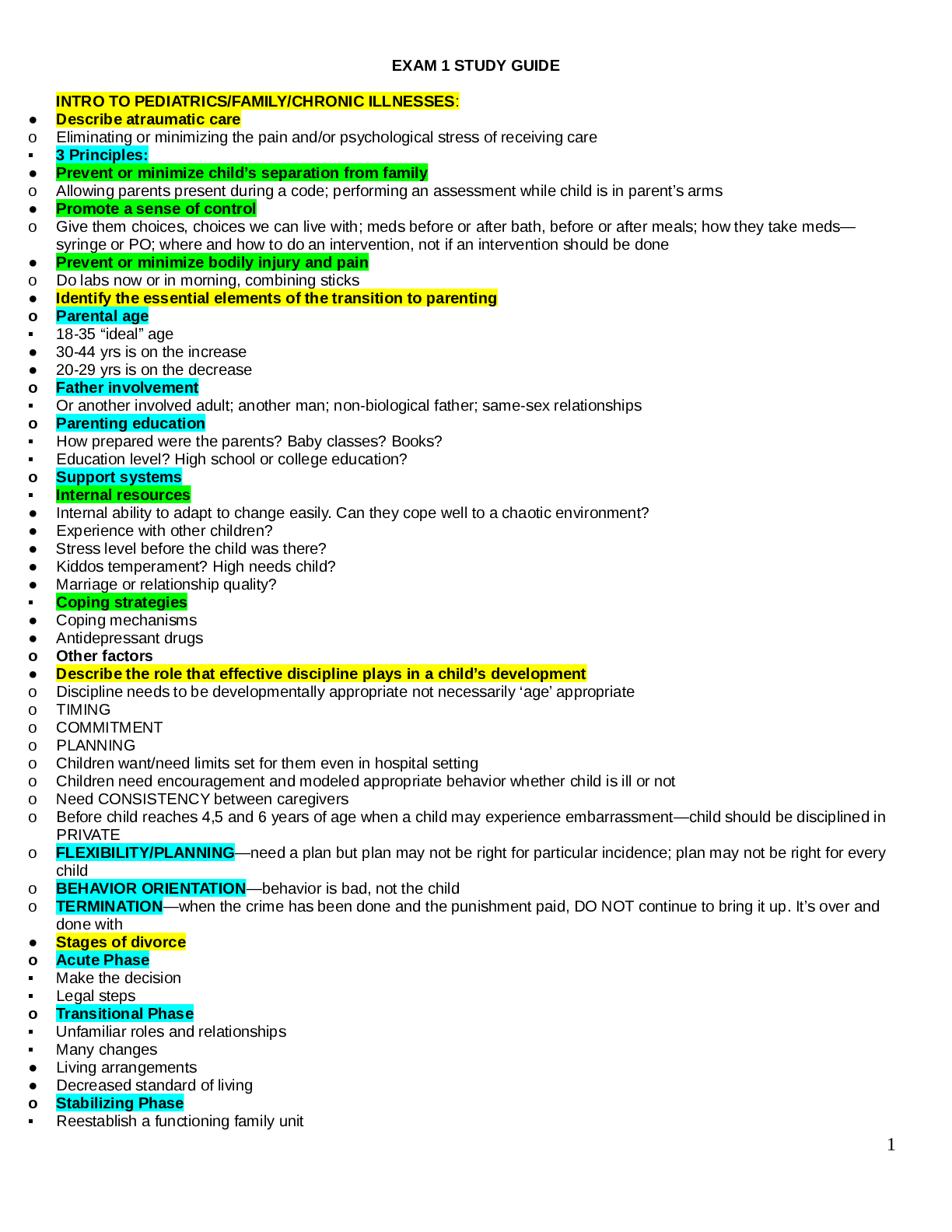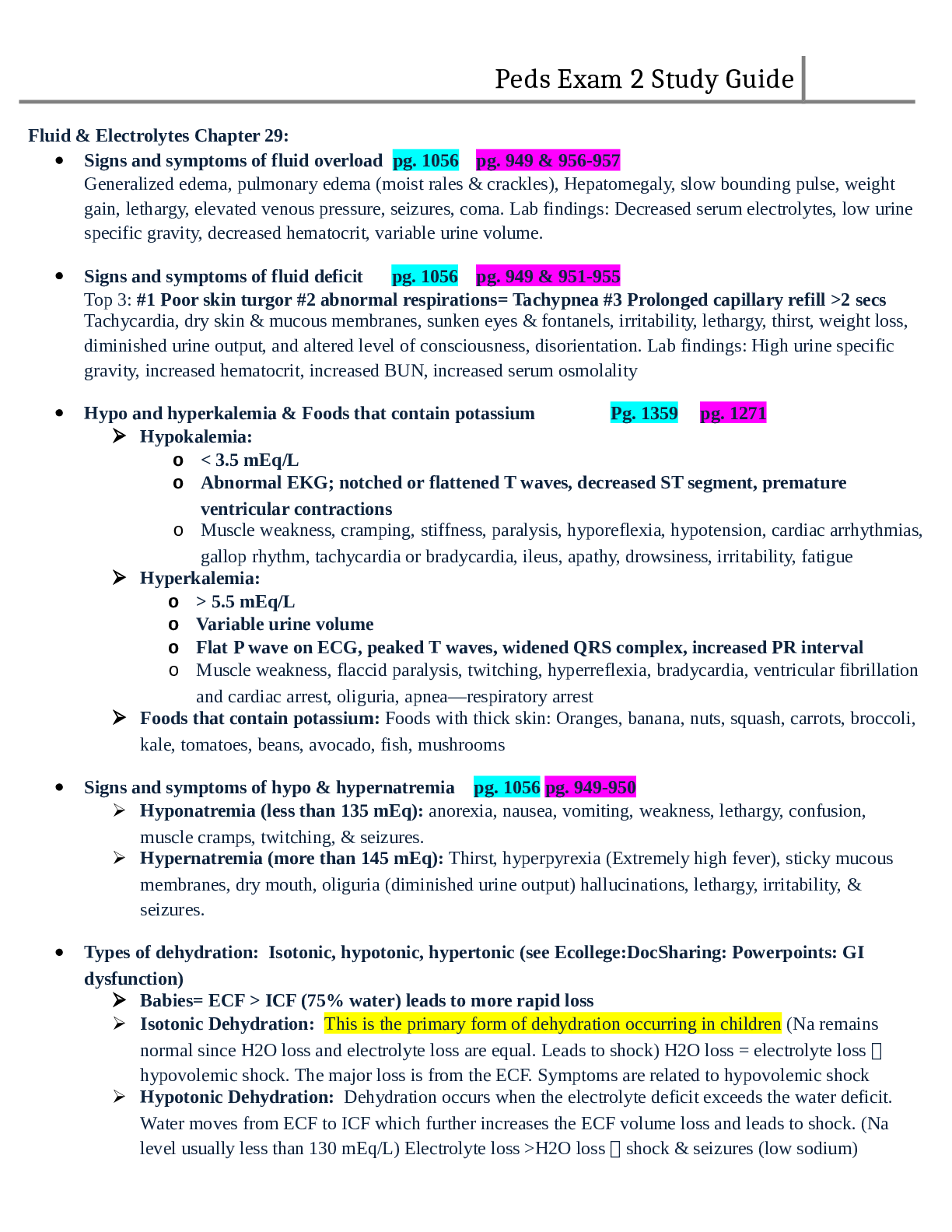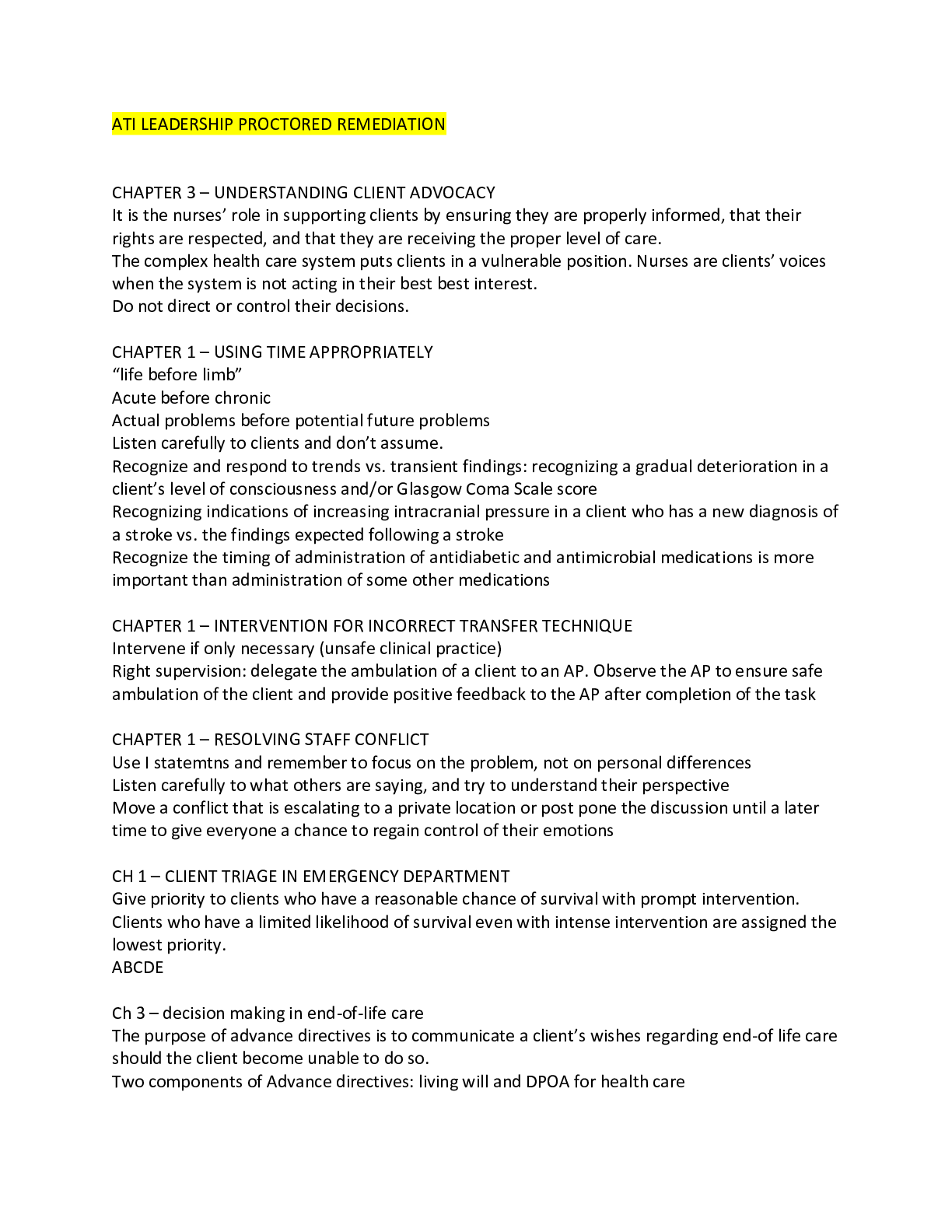*NURSING > STUDY GUIDE > RN Leadership Proctored Remediation (New, 2022)|100% Correct, SATISFACTION GUARANTEED (All)
RN Leadership Proctored Remediation (New, 2022)|100% Correct, SATISFACTION GUARANTEED
Document Content and Description Below
huy Pham - ATI LEADERSHIP PROCTORED RTAKE REMEDIATION CHAPTER 3 – UNDERSTANDING CLIENT ADVOCACY It is the nurses’ role in supporting clients by ensuring they are properly informed, that their r... ights are respected, and that they are receiving the proper level of care. The complex health care system puts clients in a vulnerable position. Nurses are clients’ voices when the system is not acting in their best best interest. Do not direct or control their decisions. CHAPTER 1 – USING TIME APPROPRIATELY “life before limb” Acute before chronic Actual problems before potential future problems Listen carefully to clients and don’t assume. Recognize and respond to trends vs. transient findings: recognizing a gradual deterioration in a client’s level of consciousness and/or Glasgow Coma Scale score Recognizing indications of increasing intracranial pressure in a client who has a new diagnosis of a stroke vs. the findings expected following a stroke Recognize the timing of administration of antidiabetic and antimicrobial medications is more important than administration of some other medications CHAPTER 1 – INTERVENTION FOR INCORRECT TRANSFER TECHNIQUE Intervene if only necessary (unsafe clinical practice) Right supervision: delegate the ambulation of a client to an AP. Observe the AP to ensure safe ambulation of the client and provide positive feedback to the AP after completion of the task CHAPTER 1 – RESOLVING STAFF CONFLICT Use I statemtns and remember to focus on the problem, not on personal differences Listen carefully to what others are saying, and try to understand their perspective Move a conflict that is escalating to a private location or post pone the discussion until a later time to give everyone a chance to regain control of their emotions CH 1 – CLIENT TRIAGE IN EMERGENCY DEPARTMENT Give priority to clients who have a reasonable chance of survival with prompt intervention. Clients who have a limited likelihood of survival even with intense intervention are assigned the lowest priority. ABCDE Ch 3 – decision making in end-of-life care The purpose of advance directives is to communicate a client’s wishes regarding end-of life care should the client become unable to do so. Two components of Advance directives: living will and DPOA for health care This study source was downloaded by 100000831988016 from CourseHero.com on 04-19-2022 09:52:17 GMT -05:00 https://www.coursehero.com/file/27860124/ATI-Leadership-Proctored-Remediationdocx/ Living will = expresses client’s wishes regarding medical treatment of CPR, mechanical ventilation or feeding by artificial means. Treatments that have the capacity to prolong life DPOA = person who serves in the role of health care surrogate to make decisions for the client should be very familiar with the client’s wishes Ch 3 – Verifying Informed Consent Emancipated minors (minors who are independent from their parents such as a married minor) can provide informed consent for themselves A trained medical interpreter must be provided if patient is unable to communicate due to a language barrier Ch 17 – Assessing a Client’s understanding a pulmonary function tests PFTs determine lung function and breathing difficulties Measures lung volumes and capacities, diffusion capacity, gas exchange, flow rates, and airway resistance, along with distribution of ventilation Helpful in identifying clients who have lung disease Commonly performed for clients who have dyspnea Ch 2 – Objectives of telehealth Distribution of health-related services and information via electronic information and telecommunication technologies. Collaboration with the interprofessional team Ch 5 – Responding to unsafe medication administration Incident report should be completed by the person who identifies that an unexpected event has occurred. This might not be the individual most directly involved in the incident. Should be completed as soon as possible and within 24 hours of the incident Ch 6- Reportable infectious diseases Anthrax ● Botulism ● Cholera ● Congenital rubella syndrome (CRS) ● Diphtheria ● Giardiasis ● Gonorrhea ● Hepatitis A, B, C ● HIV infection ● Influenzaassociated pediatric mortality ● Legionellosis/Legionnaires’ disease ● Lyme disease ● Malaria ● Meningococcal disease ● Mumps ● Pertussis (whooping cough) ● Poliomyelitis, paralytic ● Poliovirus infection, nonparalytic ● Rabies (human or animal) ● This study source was downloaded by 100000831988016 from CourseHero.com on 04-19-2022 09:52:17 GMT -05:00 https://www.coursehero.com/file/27860124/ATI-Leadership-Proctored-Remediationdocx/ Rubella (German measles) ● Salmonellosis ● Severe acute respiratory syndromeassociated coronavirus disease (SARSCoV) ● Shigellosis ● Smallpox ● Syphilis ● Tetanus/ C. tetani ● Toxic shock syndrome (TSS) (other than Streptococcal) ● Tuberculosis (TB) ● Typhoid fever ● Vancomycinintermediate and vancomycinresistant Staphylococcus aureus (VISA/VRSA) Ch 10- Evaluating Sterile Technique Top flap away from body, grasp tip of top flap of the package and with arm positioned away from the sterile field, unfold the top flap away from body Open side flaps using right hand and left hand Grab last flap and turn it down toward the body Additional sterile packages: pull back on top flap and add them directly to the sterile field by holding it 6 inches above sterile field and dropping it onto the field Pouring sterile solutions: remove bottle cap, placing the bottle cap face up on a clean (nonsterile) surface, hold the bottle with the label in the palm Do not touch bottle to the site Don sterile gloves Ch 4 – Teaching newly licensed nurse on restraint protocol The provider must rewrite the prescription, specifying type of restraint, every 24 hour or the frequency time specified by facility policy Conduct neurosensory checks every 2 hour: circulation, sensation, mobility Offer food and fluids Use a quick-release knot to tie the restraint to a bed frame [Show More]
Last updated: 2 years ago
Preview 1 out of 4 pages

Buy this document to get the full access instantly
Instant Download Access after purchase
Buy NowInstant download
We Accept:

Reviews( 0 )
$11.00
Can't find what you want? Try our AI powered Search
Document information
Connected school, study & course
About the document
Uploaded On
Apr 19, 2022
Number of pages
4
Written in
Additional information
This document has been written for:
Uploaded
Apr 19, 2022
Downloads
0
Views
109









